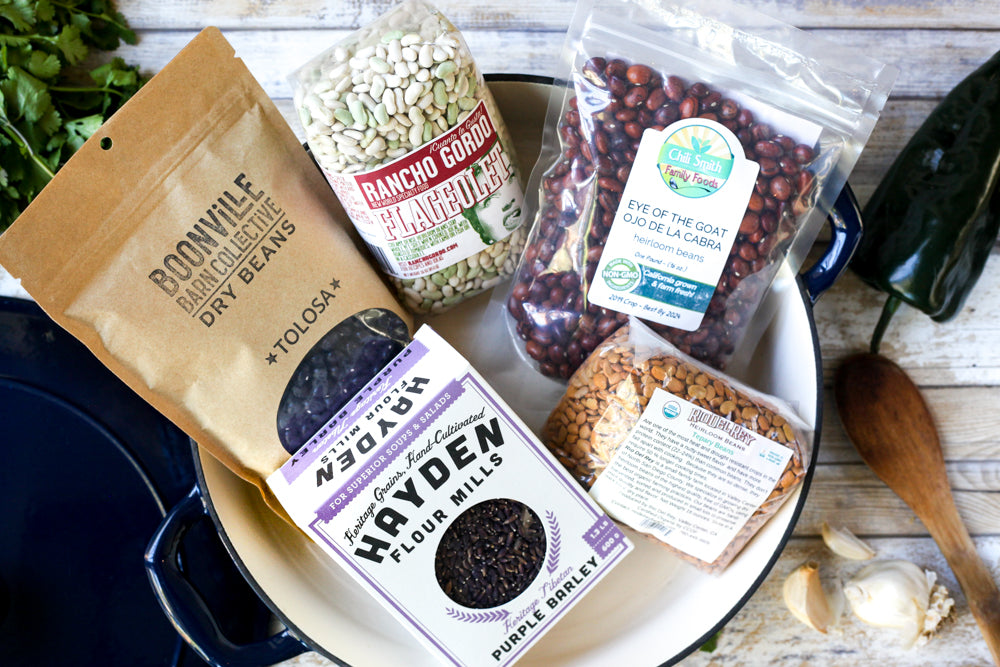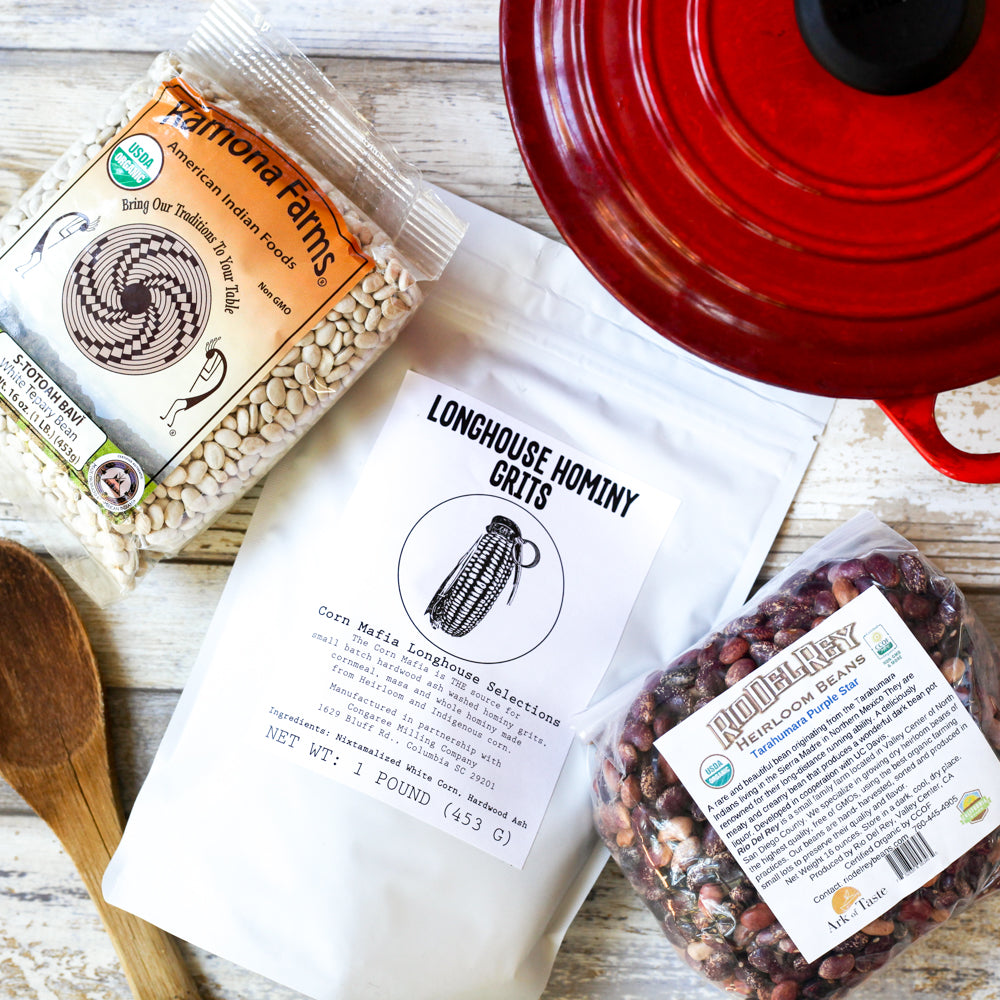10.99 FLAT RATE SHIPPING
10.99 FLAT RATE SHIPPING
SHOP

March Heirloom Bean And Grain Club
February 27, 2022 7 min read
A legendary bean from the basque region and possibly the only bean to boast its own week long festival is our March bean club feature. Cheesy bean bakes, creamy soups and chili dominate our meal plans this month with Tolosa black beans and Eye of the Goat, but we have an eye towards spring with some purple barley and in the family box delicate flageolet will compliment spring lamb and brown tepary will adorn your vegan salads.
FAMILY SIZE CONTAINS:
Tolosa, Organic Eye Of The Goat Beans, Flageolet, Organic Black Tepary, Heritage Tibetan Purple Barley*
REGULAR SIZE CONTAINS:
Tolosa Black, Organic Eye Of The Goat Beans, Heritage Tibetan Purple Barley*
BEAN ONLY CONTAINS:
Tolosa Black, Organic Eye Of The Goat Beans, Organic Black Tepary
*Gluten Free Substitute - Fonio

TOLOSA BEANS
There are many famous beans in the world but few beans are as celebrated as the Tolosa. Basques take their beans seriously but the Tolosa is elevated to an almost religious level. It is so revered that each year the tiny town of Tolosa located in the Basque province of Gipúzkoa, pulls out all the stops for a Babarrunaren Astea, "week of the bean." They even have their own "Brotherhood of the Bean" which produces delicious vats of the iconic Tolosa stew for the festival.
The Atlantic pronounce this legendary legume the most famous bean in Spain a decade ago. Ironically the Tolosa originated in the new world, not Spain or France. It was brought to the region from Venezuela two centuries ago, along with the traditional method of cultivating it with corn.
I'm struck by how similar the Tolosa looks to the heritage Oaxacan black bean from January. They both resemble shiny black beads with a trademark single white spot and they almost too pretty to eat. The difference however is the color. Black beans from Tolosa aren’t actually black. These famous legumes are really a beautiful dark purple and you'll certainly find a few in your bag that are more lavender than black. After the traditional long slow simmer in salted water and olive oil, they’ll be swimming in a velvety purple broth worth lapping up with bits of crusty bread. One bite and you'll see why these buttery delicate beans have become so famous. They are now grown in other parts of Europe but they are nearly impossible to find in the US, even imported. Lucky for you the folks at Boonville Barn Collective are obsessed with all things Basque and we got our hands on a small quantity this year.
WHAT TO DO WITH THEM
Like so much of the best food from Spain, they are traditionally treated very simply. Just water, salt, olive oil and beans simmered low and slow for 3 hours. No garlic, tomatoes, ham hock or even a bayleaf. The instructions are simple. Rinse the beans and cook one pound of beans with 6 cups of salted water and a generous pour of good olive oil. Bring to a boil then simmer for 3 hours until silky and soft. NEVER stir the beans ever or they will break. You can gently shake the pot to check the water level from time to time but no stirring at all. After they are done cooking allow to cool for 20 minutes so that the broth can thicken in to a delicious stew. To complete the iconic Tolosan meal serve them with spanish sausage and cabbage wilted with garlic and olive oil and sprinkled with a bit of Piment d'Espelette.
Don't forget some Piment d'Ville to go with your Basque meal!
We're including a little surprise for club members. You'll get a little sample pack of Piment d'Ville to enjoy with your basque meal. This sweet and spicy Basque espelette pepper is locally grown in California and meticulously hand harvested by farmer Nacho in the small town of Boonville. Basque Chefs call Piment d'Ville "The Third Spice" and use it in their cooking as often as they use salt & pepper. The Piment d'Ville pepper is sweet and spicy, warm not hot. It's adds a just the perfect splash of flavor to your favorite dishes. We sprinkled some on our wilted cabbage to go with that classic Tolosa stew!
ABOUT THE FARMERS

Boonville Barn Collective uses sustainable agricultural techniques to produce healthy food without compromising future generations' ability to do the same. Located 100 miles north of San Francisco their farm is Renegade certified.
What started as a way to produce a locally grown Basque chile powder has evolved into a venture focused on building community and growing great spices and beans. They don't grow chiles just because they make our food taste incredible. They grow these chiles and produce value-added products in order to provide their team with better working conditions than conventional farms offer, to pay their team better than other agricultural work does, and so they can ALL be proud of the work they do. We're so proud to support them in the important work they are doing for the community and the planet.
Cheesy Basque Bean Bake
Gooey cheese and loads of flavors from the Basque region make this very simple meal a meatless Monday hit all winter long. I originally wrote this recipe to go with the Tolosa Beans but we had such a limited supply that one package you got in the club is likely to the the only one you'll get all year long. Luckily this recipe works just as well with Eye of the Goat!
EYE OF THE GOAT
 The Eye Of The Goat (or "Ojo de Cabra" Beans) is a much beloved, and drop dead gorgeous heirloom with a distinctive swirl pattern creating its "eye." With delicate thin skins a robust flavor and a rich bean broth they are a favorite from Baja in Mexico. This is one of those beans that has so much flavor it needs nothing more than salt, olive oil and possibly a bay leaf. Sure you can get fancy but a basic pot of beans will produce gourmet quality with little effort. Feeling adventurous? Try this Goat Chili with Eye of the Goat from Food and Wine. For the less inclined to eat actual goat, here's a delicious vegetarian recipe (easily turned vegan) for Eye of The Goat With Salsa Verde and Feta.
The Eye Of The Goat (or "Ojo de Cabra" Beans) is a much beloved, and drop dead gorgeous heirloom with a distinctive swirl pattern creating its "eye." With delicate thin skins a robust flavor and a rich bean broth they are a favorite from Baja in Mexico. This is one of those beans that has so much flavor it needs nothing more than salt, olive oil and possibly a bay leaf. Sure you can get fancy but a basic pot of beans will produce gourmet quality with little effort. Feeling adventurous? Try this Goat Chili with Eye of the Goat from Food and Wine. For the less inclined to eat actual goat, here's a delicious vegetarian recipe (easily turned vegan) for Eye of The Goat With Salsa Verde and Feta.

ABOUT THE MAKER
Primary Beans is a brand-new, sister-founded purveyor of single-origin dried beans from recent harvests on a mission to place the almighty bean at the forefront of meals that are good for people and the planet.
Linsey and Renee are fifth-generation Arizonans from a small town on the Mexican border. Like any border town kids, they grew up around the culture and flavors of Northern Mexico. Early on, they developed a deep appreciation for beans and were the kids asking for “no rice, only beans please” at the local restaurant.
Turning their passion into a mission, the sisters created Primary Beans to deepen our connection to the food we eat and the land it comes from. They ethically source fresh, delicious beans from their network of family farms to deliver them to your table.
 HERITAGE TIBETAN PURPLE BARLEY
HERITAGE TIBETAN PURPLE BARLEY
Heritage Tibetan Purple Barley has a deep, earthy flavor to match its distinctive color. The deep purple grain is high in antioxidants. Discovered in Tibet, this variety of purple barley was first brought to the United States almost 100 years ago but was locked away in seed vaults with little attention. Luckily farms like Hayden Mills are bringing back this nutritious whole grain. With a stunning color and a delicious nutty flavor it's a favorite of ours in grain bowls, salads and soups. It can be used as a substitute for rice and makes a delicious faux risotto. Barley is not gluten free but it is low in gluten making it a healthy alternative for people who can tolerate some gluten in their diets.
What To Do With It
Deliciously nutty, purple barley makes excellent salads, grain bowls and this substitutes for rice in this yummy risotto recipe from the New York Times. It's the perfect way to elevate a mushroom barley soup. In this hazelnut elderberry purple barley salad, we combine it with hazelnut oil, elderberry balsamic, pecans and berries to create one of our favorite cold salads to enjoy all year long.
FLAGEOLET
 This heirloom bean is a European classic similar to a navy bean and a favorite around Rancho Gordo. They are dried to the most beautiful spring green but turn creamy white when cooked. Flageolet is mild and creamy and pairs perfectly with chicken, fish or lamb but also make a wonderful vegetarian dish. They work great in anything slow cooked like a cassoulet because although they are mild and tender they hold their shape with long cooking. We love them slow cooked on the stove with stock, onion and tomatoes. The flageolet is a favorite among many chefs for everything from soups to sides and they'll find a perfect place on your table. Our latest recipe for Roasted Cauliflower and Flageolet Soup is a standout, It bridges the gap between still chili temps and our desire to welcome in spring. This delicious lemony salad by Martha Stewart is a staff favorite and we think it would make a great addition to your Easter table. If you're looking for something a little warmer, this creamy flageolet soup recipe from New York Times is delicious.
This heirloom bean is a European classic similar to a navy bean and a favorite around Rancho Gordo. They are dried to the most beautiful spring green but turn creamy white when cooked. Flageolet is mild and creamy and pairs perfectly with chicken, fish or lamb but also make a wonderful vegetarian dish. They work great in anything slow cooked like a cassoulet because although they are mild and tender they hold their shape with long cooking. We love them slow cooked on the stove with stock, onion and tomatoes. The flageolet is a favorite among many chefs for everything from soups to sides and they'll find a perfect place on your table. Our latest recipe for Roasted Cauliflower and Flageolet Soup is a standout, It bridges the gap between still chili temps and our desire to welcome in spring. This delicious lemony salad by Martha Stewart is a staff favorite and we think it would make a great addition to your Easter table. If you're looking for something a little warmer, this creamy flageolet soup recipe from New York Times is delicious.
ABOUT RANCHO GORDO
Rancho Gordo beans by Steve Sando are kinda a big deal. It started as a hobby of growing heirloom beans and figuring out different ways to cook them and quickly led to farmer’s markets. When the people started loving all the varieties he grew, as much as Steve did, he knew he was onto something good. Read More...
ORGANIC BLACK TEPARY BEANS
These Non-GMO heirloom black beans are a very rare variety of the Native American tepary bean. They are a delicious and more nutritious alternative to traditional black beans. Born of an ancient tradition of separating the black seeds before planting the white or brown teparies, the black seeds were selected, planted, grown, and harvested over several years to bring out the hidden traits of this unique tepary bean. The s-chuuk bavi (black tepary bean) has a firm, meaty texture and a distinctive flavor with a hint of lime that makes it perfect for Mexican cuisine. Try them in replace of black beans in all of your favorite recipes.
Tepary beans are the original superfood of the Sonoran Desert having sustained Native American people for countless generations. Ramona Farms shares with us their traditional foods grown on the ancestral lands of the Akimel O'Odham (Gila River Pima) tribe in Arizona's Sonora Desert. An ingredient in the Slow Food Ark of Taste, the tepary bean is believed to be the world’s most drought tolerant bean, and higher in fiber and protein than most other beans with a low glycemic index and superior taste.
Read more about Ramona Farms and the tepary bean here.
Recent Articles
About Us
Foodocracy is dedicated to creating a more sustainable and independent food system. We support small, independent farms across the nation.
Get impossible to find beans and grains shipped direct to your doorstep each month from small family farms.
We support small, family owned farms across the nation. Did you know that farmers only make an average of 10 cents on every dollar you spend at the supermarket? Working directly with farms and not middle men ensures that more money goes back to the people actually growning your food.
Get 10% Off
Sign up for delicious recipes and special offers.
**Regularly priced items only.







